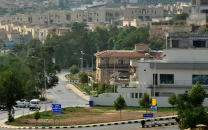K-P's twin battles: terrorism and climate
Climate change is no longer a mere concept that is debated in conference halls

For more than two decades, Khyber Pakhtunkhwa has been a frontline province in the war against terrorism. The human cost has been massive, thousands of lives lost, livelihoods destroyed, and entire communities have been left traumatized. The financial cost has been no less severe, with provincial resources consistently diverted toward security and reconstruction.
Yet, as Khyber Pakhtunkhwa has been working towards establishment of peace, another quieter war has been taking shape, one that cannot be fought with guns or military operations. This is the war against climate change, and the province now finds itself on the frontlines of both conflicts at the same time.
Climate change is no longer a mere concept that is debated in conference halls and international seminars. It has become a living reality for millions in Pakistan now. On 15th of August, just a couple of days back, Khyber Pakhtunkhwa faced one of its deadliest weather disasters, with more than 279 deaths reported across across the province due to heavy rains, cloudbursts, flash floods, and lightning. Buner suffered the highest toll with 181 deaths, followed by Shangla, Swat, Bajaur, Mansehra and Battagram. Entire families perished, dozens remain missing, and over 50 houses were destroyed or damaged. Schools, bridges, hotels, vehicles, and livestock were lost, while key roads remain blocked.
Just weeks before the current disaster, Khyber Pakhtunkhwa endured severe monsoon floods and landslides, killing at least 29 people and leaving dozens injured. On June 27, the Swat River tragedy claimed 13 members of one family. Torrential downpours triggered glacial lake outbursts and major road blockages, isolating communities and damaging hundreds of homes, schools, bridges, and roads. Rescue 1122 and PDMA led relief efforts, but recovery remained incomplete when August's floods struck.
According to Germanwatch's Global Climate Risk Index, Pakistan remains at a higher risk and among the most climate vulnerable nations in the world. The 2022 floods was a national tragedy that claimed more than 1,700 lives and caused over $30 billion in damage according to certain estimates. Entire districts were submerged, crops were destroyed, and infrastructure, that was built in decades, was swept away in days.
Khyber Pakhtunkhwa's vulnerability to climate change is amplified by its unique geography. The province is home to part of the Hindu Kush Mountain range, a region containing some of the world's largest glaciers. These glaciers are more than natural wonders; they are critical water sources for millions of people.
But rising global temperatures are melting them at an alarming rates. This has created thousands of glacial lakes, many of them unstable. These lakes pose the risk of glacial lake outburst floods (GLOFs), sudden, powerful surges of water that can obliterate everything in their path.
We have already witnessed this danger. In 2022, part of the Mankial Glacier in Swat broke away, causing destruction downstream. In Chitral's Broghil Valley, near the Wakhan Corridor that links Pakistan to Afghanistan and Central Asia, the glaciers are retreating at an alarming rate and experts warn of catastrophic consequences. A single major outburst could devastate vast areas, wiping out homes, farmland, and critical infrastructure on both sides of the border.
If terrorism demands strong security networks, climate change demands equally robust early warning systems. Globally, these systems have proven to be lifesavers, giving communities the precious hours or even minutes needed to evacuate before disaster strikes.
In partnership with the UNDP, the Pakistan Meteorological Department (PMD), and the Green Climate Fund, Khyber Pakhtunkhwa has made progress.





















COMMENTS
Comments are moderated and generally will be posted if they are on-topic and not abusive.
For more information, please see our Comments FAQ